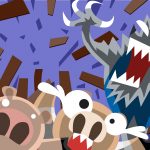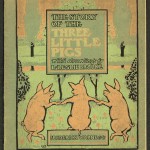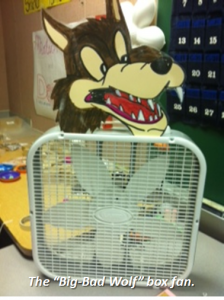Three Little Pigs Design Challenge
Activity developed by educators at the Mid-Columbian STEM Education Collaboratory. Click HERE for PDF.
Another version of this design activity, using sandcastles, can be found here. Adapted from TeachEngineering’s Engineering for the Three Little Pigs, it originally ran in the August 2014 eGFI Teachers’ newsletter.
Summary
Three teams of elementary students act as civil and structural engineers to design and build a house using a finite amount of materials that the big, bad wolf cannot blow down.
Grade level: K-5 but can be adapted for older and younger students
Time: 45-60 minutes
Learning objectives
After doing this challenge, students should be able to:
- Understand and follow the steps in the engineering design process
- Evaluate the effectiveness of different materials
- Work within the constraints of time and materials, as engineers do
- Work with teammates to accomplish a task
Learning standards
Next Generation Science Standards
Physical Science and Engineering Design. Students who demonstrate understanding can:
- K-PS2-1 Plan and conduct an investigation to compare the effects of different strengths or different directions of pushes and pulls on the motion of an object.
- K-PS2-2 Analyze data to determine if a design solution works as intended to change the speed or direction of an object with a push or a pull.
- 2-PS1-2 Analyze data obtained from testing different materials to determine which materials have the properties that are best suited for an intended purpose
- 3-PS2-1 Plan and conduct an investigation to provide evidence of the effects of balanced and unbalanced forces on the motion of an object.
- 3-PS2-2 Make observations and/or measurements of an object’s motion to provide evidence that a pattern can be used to predict future motion.
- K-2-ETS1-1 Ask questions, make observations, and gather information about a situation people want to change to define a simple problem that can be solved through the development of a new or improved object or tool.
- K-2-ETS1-2 Develop a simple sketch, drawing, or physical model to illustrate how the shape of an object helps it function as needed to solve a given problem.
- K-2-ETS1-3 Analyze data from tests of two objects designed to solve the same problem to compare the strengths and weaknesses of how each performs.
- 3-5-ETS1-1 Define a simple design problem reflecting a need or a want that includes specified criteria for success and constraints on materials, time, or cost.
- 3-5-ETS1-2 Generate and compare multiple possible solutions to a problem based on how well each is likely to meet the criteria and constraints of the problem.
- 3-5-ETS1-3 Plan and carry out fair tests in which variables are controlled and failure points are considered to identify aspects of a model or prototype that can be improved.
Common Core State Literacy Standards
- Kindergarten: With prompting and support, ask and answer questions about key details in a text; retell familiar stories, including key details; and identify characters, settings, and major events in a story.
- First Grade: Ask and answer questions about key details in a text; Retell stories, including key details, and demonstrate understanding of their central message or lesson; Describe characters, settings, and major events in a story, using key details.
- Second Grade: Ask and answer such questions as who, what, where, when, why, and how to demonstrate understanding of key details in a text; recount stories, including fables and folktales from diverse cultures, and determine their central message, lesson, or moral; and describe how characters in a story respond to major events and challenges.
- Third Grade: Ask and answer questions to demonstrate understanding of a text, referring explicitly to the text as the basis for the answers; recount stories, including fables, folktales, and myths from diverse cultures; determine the central message, lesson, or moral and explain how it is conveyed through key details in the text; and describe characters in a story (e.g., their traits, motivations, or feelings) and explain how their actions contribute to the sequence of events.
- Fourth Grade: Refer to details and examples in a text when explaining what the text says explicitly and when drawing inferences from the text; determine a theme of a story, drama, or poem and summarize the text; and describe in depth a character, setting, or event in a story or drama, drawing on such details as a character’s thoughts, words, or actions.
- Fifth Grade: Quote accurately from a text when explaining what the text says explicitly and when drawing inferences from the text; determine a theme of a story, drama, or poem from details in the text, including how characters in a story or drama respond to challenges or how the speaker in a poem reflects upon a topic; and summarize the text.
See Oklahoma Education Department’s question scaffolding for The Three Little Pigs and Bloom’s deeper learning.
Materials
For each team:
- Approximately 50 Popsicle sticks for Team 1
- Approximately 50 small straws (e.g., for hot drinks) for Team 2
- Approximately 50 index cards for Team 3
- 1 thick, cardboard base (e.g., 5 ½ in.×8 in.) to serve as a foundation
- 1 poster board roof (e.g., 4 in.×8 in.)
- 1 yard of masking tape
- 1 piece of paper and a pencil
For each student:
- 1 Reflection Page (see supplemental materials)
For the group:
- 1 copy of The Three Little Pigs by Paul Galdone (or other version)
- 1 multi-speed box fan; if only a single speed is available, distance from the fan can be decreased to achieve low, medium, and high wind speeds.
- 1 Data Table (see Supplemental Materials)
Procedure
Preparation
In order to turn the box fan into the “Big, Bad Wolf,” consider printing out and adhering the picture of the wolf to the top of the fan (see Supplemental Materials and Artifacts documents). Then, “low” fan speed can be referred to as “Huffing and Puffing Level 1,” and so forth.
Set up a “Materials Science Table” for teams to pick up what they need for the challenge. When deciding on supplies to serve as “straw, sticks, and brick,” consider possible recycled or reuse items (see Artifacts document). The materials described in this lesson are easily found in formal or informal educational settings, or available for purchase at low cost. If you are working with more than three groups, variations on building materials can also be tried (see below for “Materials Science Adaptation”).
It is recommended that foundations and roofs are made of the same materials for all groups for a more accurate comparison of the effects of different building materials (e.g., straw, sticks, and brick).
Introduce the challenge
- Read The Three Little Pigs aloud to the class. Consider using the GLAD (Guided Language Acquisition Design) Narrative input chart as a strategy to support early reader and language-diverse students.
- After reading, discuss the need to build a good strong house. Consider linking it to local weather conditions (e.g., wind, tornadoes, and hurricanes; see Artifacts document for an example).
- Divide students or participants into at least three teams of two.
- Introduce the “Three Little Pig STEM Design Challenge Requirements Card” (see Supplemental Materials). For example:Your house must be built on the foundation provided and use the roof provided. (Note: The roof is the top of the house and the foundation what the house is built on.)Your house must be built with only the materials you are provided.Your team must have “fair-share work”- listen to all ideas!Your team only has 20 minutes to complete this task and be ready for testing
- Introduce students to the “Engineering Design Process” (see Supplemental Materials and Artifacts documents).
- Show students the “Big, Bad Wolf” fan so they understand the force of the wind (i.e., huffing and puffing level) they will be trying to build the house to withstand.
- Assign each team a material to work with (e.g., straw, sticks, or brick).
- Encourage students to draw or sketch a design idea first. Note: This step supports the NGSS (Next Generation Science Standard) Science and Engineering Practices of “Planning and carrying out Investigations” and “Developing and using models.”
- Hand out or have one person from each team gather the appropriate building materials from the Materials Science Table. Pass out one yard of masking tape to each team. Each group is only assigned or given one material to work with.
- Establish a time limit for designing, redesigning, and building and allow teams to start building (e.g., 20 minutes).
- When time is up, have each team bring their house to the testing zone where they can share their design with other groups.
- Have the students place/orient their house in the test zone as they wish it to be tested. Note: The same distance from the fan should be used for all groups.
- Turn the fan on low (i.e., Huffing and Puffing Level 1) for 10 seconds. If it survives, go to medium (i.e., Huffing and Puffing Level 2) for 20 seconds. If it survives, turn the fan high (i.e., Huffing and Puffing Level 3” for 30 seconds. If the house is still standing…. SUCCESS! If not, it is a good opportunity for teams to think of design improvements after seeing other houses.
- Use the group Data Table to record each team’s results for analysis. Note: This step the NGSS-Science and Engineering Practices of “Analyzing and Interpreting Data.”
- Test all houses.

- Discuss results as a group.
- Have each team discuss and document what they would do to improve their design. If time allows, have each team give an oral presentation of what they would do to optimize their house design. This adaptation supports the Common Core State Standards (CCSS) of “Speaking and Listening,” as well as NGSS Science and Engineering Standard of “Obtaining, evaluating, and communicating information.”
- If time allows, have teams modify (i.e., re-design) and re-test.
- Hand out one “Student Reflection Page” to each student. (See supplemental materials; see artifacts pages for examples.) Allow students reflection time to evaluate their work and design.
Conclusion
Group discussion or written responses as time and age level allows.
- Based on the “Data Table,” what materials appear to withstand the huffing and puffing of the “Big, Bad Wolf” the best?
- Why do you think these materials were more effective than others?
- Was your team able to design and build a house that survived the “Big, Bad, Wolf?”
- What “Huffing and Puffing” level did your house withstand?
- Even if your house survived, what would you do to improve your design based on other houses that you observed?
- Thinking about the real world, can you come up with a list of all the different jobs or people need to build just one house?
- How many of these jobs require an understanding of science, technology, engineering, and/or math? (star or highlight them on the list)
Activity scaling/extension
For upper level students or to increase the level of challenge, add the task of engineering the roof and foundation within certain constraints (e.g., specific sizes or specific materials as described in the “Materials” section).
For multicultural students, introduce The Three Little Pigs in different cultural contexts, (e.g., The Three Little Javelinas, a southwestern adaptation, by Susan Lowell, illustrated by Jim Harris). Consider having multiple versions on display for participants to explore.
Math Connection/Adaptation: To increase math understanding, students can inventory the supplies used in the house. The instructor could supply a cost sheet, which could vary in complexity for the different ages of students. Students can evaluate the final cost of their home and share that as part of presenting their design for testing.
Regardless of design success when tested in front of the box fan, the instructor could challenge students to figure out the cost of improvement to meet success, or to minimize total cost.
Materials Science Adaptation: Different sized “straws” (e.g., coffee, soda, or wide-mouth, etc.), “sticks” (e.g., Popsicle sticks of different lengths and widths, wooden stirring sticks, real sticks, etc.), and “bricks” (e.g., cardboard from cereal boxes, cleaned and cut-out juice carton walls, glued vs. unglued index cards, etc.) can be used to test the effects that building materials, from the same category, can have on design performance. Styrofoam bases (e.g., cleaned food packaging materials) could serve as the foundation for the houses instead of cardboard, or corrugated cup holders instead of poster board could serve as roofs. Different costs can be associated with different materials of the same category, as well. See artifacts document for ideas.)
Filed under: Class Activities, Grades K-5
Tags: Civil Engineering, Class Activities, Design, design challenge, ELA, Engineering Design Process, forces, Grades K-5, literacy, materials, NGSS, structures, three little pigs, wind








